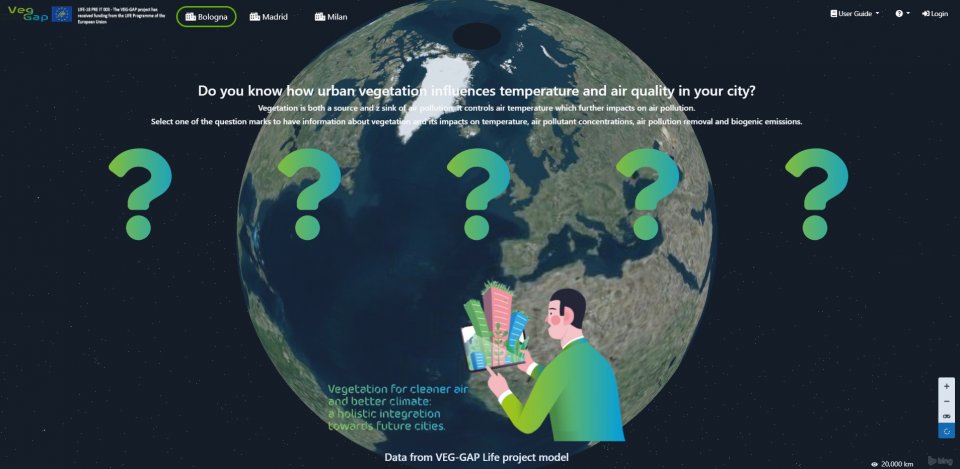
The three cities involved in the activities are Bologna, Madrid and Milano. They are different in terms of location and number of inhabitants but all need to address the problems related to pollution and climate change.
The VEG-GAP Information Platform is a web-based multi-purpose information platform exploiting the final results of the project. The platform uses Atmospheric Modelling Systems outputs. It is a collaborative framework among end-users (which can interact with data analytics), governance (facilitating the knowledge sharing on successful environmental air quality solutions), and citizens (by showing them the effects of the green interventions).
VEG-GAP is a valuable example of transnational collaboration, and of how cities, research centres, businesses and civil society can team up to build better cities.
The overall objective is to take advantage of the interactions of vegetation ecosystems with urban atmosphere, the simultaneous effects of vegetation on air temperature and air quality for the most significant pollutants.
VEG-GAP evaluations are based on Atmospheric Modelling Systems (AMS): numerical models that employ a set of equations and many parametrizations to describe the multiple physical and chemical phenomena and processes which take place in atmosphere. AMS provide insights into the effects of vegetation on air quality and temperature in the city, by comparing different simulations which consider the type and quantity of plants in present and future configuration.
- Collect relevant information on initiatives and projects related to urban ecosystems/vegetation and air pollution.
- Collect, evaluate and map the air pollution characteristics of ecosystems/vegetation in the partner municipalities.
- Assess and map biogenic emissions as a function of ecosystems/vegetation type and as a function of meteorological conditions in the partner municipalities.
- Assess the role of ecosystems/vegetation on urban heating/cooling and the relation with air pollution in the partner municipalities.
- Assess the impact of ecosystems/vegetation on health and ecosystem risks due to their effect on air pollution in the partner municipalities.
- Develop an information platform and tools to support authorities.
The approach used in VEG-GAP quantifies simultaneously the contribution of vegetation ecosystems both as source and sink of air pollutants in urban areas, the effect of urban vegetation ecosystems on air temperature and its impact on air quality.
- Developing climate change adaptation; improving risk management and resilience
- Developing climate change mitigation
- Carbon sequestration and storage
- Increase quality and quantity of green and blue infrastructures
- Improve air quality
- Increase stakeholder awareness & knowledge about NBS
It possible to apply the Veg-Gap method using the Website and Information Platform that are essential tools to make project's results available to all technical and non-technical audience interested in conserving/changing/maintain the ecosystems/green areas in the cities and/or in implementing/testing future strategies such as nature-based solutions in the cities in order to maintain or improve air quality.
The VEG-GAP Information Platform is a web-based multi-purpose information platform, everyone can access it and no login is required. It is a collaborative framework among end-users (which can interact with data analytics), governance (facilitating the knowledge sharing on successful environmental air quality solutions), and citizens (by showing them the effects of the green interventions).
The Information Platform can be extended to include more cities and data.
This process has greatly enriched the results, bringing different perspectives, stimulating creativity and pushing for better outcomes. The project also stimulated the pilot cities to develop better air quality and climate plans for the future and to build stronger alliances with other actors.
The Veg-gap project (LIFE18 PRE IT 003) is co-financed by the LIFE European Programme
- Afforestation
Further information
- 11. Sustainable Cities and Communities
